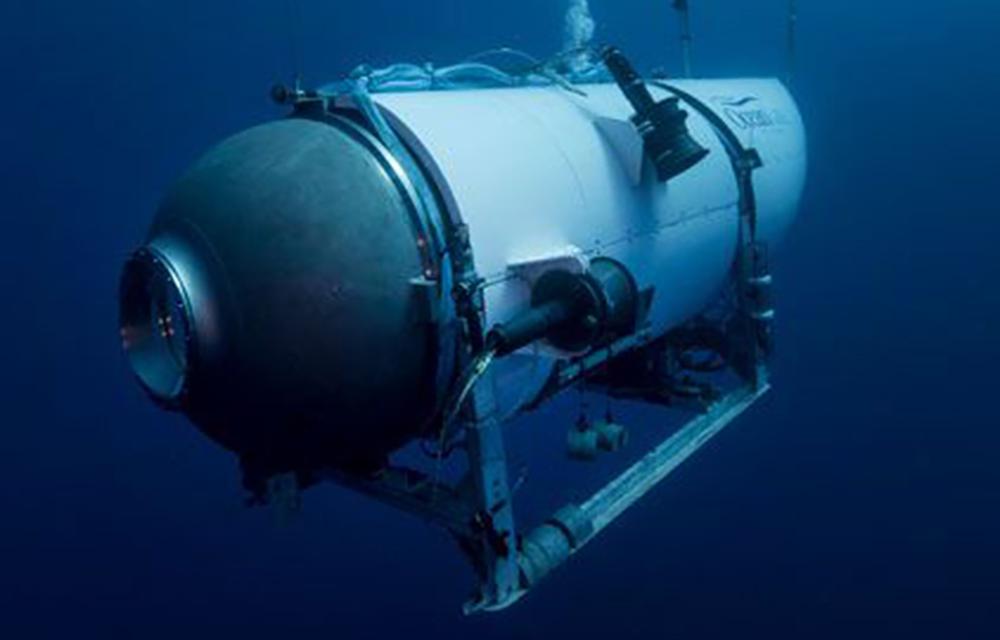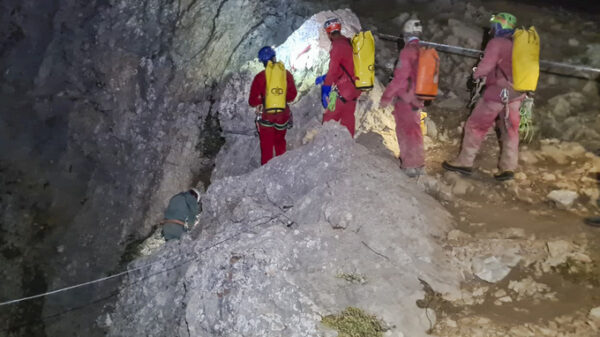FILE – This undated image provided by OceanGate Expeditions in June 2021 shows the company’s Titan submersible. The wrecks of the Titanic and the Titan sit on the ocean floor, separated by 1,600 feet (490 meters) and 111 years of history. How they came together unfolded over an intense week that raised temporary hopes and left lingering questions. (OceanGate Expeditions via AP, File)
When millionaire Steve Fossett’s plane went missing over the Nevada range in 2007, the swashbuckling adventurer had already been the subject of two prior emergency rescue operations thousands of miles apart.
And that prompted a prickly question: After a sweeping search for the wealthy risktaker ended, who should foot the bill?
In recent days, the massive hunt for a submersible vehicle lost during a north Atlantic descent to explore the wreckage of the Titanic has refocused attention on that conundrum. And with rescuers and the public fixated first on saving and then on mourning those aboard, it has again made for uneasy conversation.
“Five people have just lost their lives and to start talking about insurance, all the rescue efforts and the cost can seem pretty heartless — but the thing is, at the end of the day, there are costs,” said Arun Upneja, dean of Boston University’s School of Hospitality Administration and a researcher on tourism.
“There are many people who are going to say, ‘Why should the society spend money on the rescue effort if (these people) are wealthy enough to be able to … engage in these risky activities?’”
That question is gaining attention as very wealthy travelers in search of singular adventures spend big to scale peaks, sail across oceans and blast off for space.
The U.S. Coast Guard declined Friday to provide a cost estimate for its efforts to locate the Titan, the submersible investigators say imploded not far from the world’s most famous shipwreck. The five people lost included a billionaire British businessman and a father and son from one of Pakistan’s most prominent families. The operator charged passengers $250,000 each to participate in the voyage.
“We cannot attribute a monetary value to Search and Rescue cases, as the Coast Guard does not associate cost with saving a life,” the agency said.
While the Coast Guard’s cost for the mission is likely to run into the millions of dollars, it is generally prohibited by federal law from collecting reimbursement related to any search or rescue service, said Stephen Koerting, a U.S. attorney in Maine who specializes in maritime law.
But that does not resolve the larger issue of whether wealthy travelers or companies should bear responsibility to the public and governments for exposing themselves to such risk.
“This is one of the most difficult questions to attempt to find an answer for,” said Pete Sepp, president of the National Taxpayers Union, noting scrutiny of government-funded rescues dating back to British billionaire Richard Branson’s hot air balloon exploits in the 1990s.
“This should never be solely about government spending, or perhaps not even primarily about government spending, but you can’t help thinking about how the limited resources of rescuers can be utilized,” Sepp said.
The demand for those resources was spotlighted in 1998 when Fossett’s attempt to circle the globe in a hot air balloon ended with a plunge into the ocean 500 miles off Australia. The Royal Australian Air Force dispatched a Hercules C-130 transport aircraft to find him. A French military plane dropped a 15-man life raft to Fossett before he was picked up by a passing yacht.
Critics suggested Fossett should pay the bill. He rejected the idea.
Late that same year the US Coast Guard spent more than $130,000 to rescue Fossett and Branson after their hot air balloon dropped into the ocean off Hawaii. Branson said he would pay if the Coast Guard requested it, but the agency didn’t ask.
Nine years later, after Fossett’s plane vanished over Nevada during what should have been a short flight, the state National Guard launched a months-long search that turned up the wreckage of several other decades-old crashes without finding the millionaire.
The state said the mission had cost taxpayers $685,998, with $200,000 covered by a private contribution. But when the administration of Gov. Jim Gibbons announced that it would seek reimbursement for the rest, Fossett’s widow balked, noting she had spent $1 million on her own private search.
“We believe the search conducted by the state of Nevada is an expense of government in performance of government action,” a lawyer wrote on behalf of the Fossett estate.
Risky adventurism is hardly unique to wealthy people.
The pandemic drove a surge in visits to places like national parks, adding to the popularity of climbing, hiking and other outdoor activities. Meanwhile, the spread of cellphones and service has left many feeling that if things go wrong, help is a call away.

Some places have laws commonly referred to as “stupid motorist laws,” in which drivers are forced to foot the emergency response bill when they ignore barricades on submerged roads. Arizona has such a law, and Volusia County in Florida, home to Daytona, enacted similar legislation this week. The idea of a similar “stupid hiker law” is a regularly debated item in Arizona as well, with so many unprepared people needing to be rescued in stifling triple-digit heat.
Most officials and volunteers who run search efforts are opposed to charging for help, said Butch Farabee, a former ranger who participated in hundreds of rescue operations at the Grand Canyon and other national parks and has written several books on the subject.
Searchers are concerned that if they did charge to rescue people “they won’t call for help as soon as they should and by the time they do it’s too late,” Farabee said.
The tradeoff is that some might take that vital aid for granted. Farabee recounts a call in the 1980s from a lawyer who underestimated the effort needed to hike out of the Grand Canyon. The man asked for a helicopter rescue, mentioning that he had an important meeting the following day. The ranger rejected that request.
But that is not an option when the lives of adventurers, some of them quite wealthy, are at extreme risk.
At Mount Everest, it can cost tens of thousands of dollars in permit and expedition fees to climb. A handful of people die or go missing while hiking the mountain every year — prompting emergency response from local officials.
While the government of Nepal requires that climbers have rescue insurance, the scope of rescue efforts can vary widely, with Upneja estimating that some could cost “multiple dozens of thousands of dollars.”
Nepal’s Ministry of Foreign Affairs did not respond to a message seeking comment.
On the high seas, wealthy yachtsmen seeking speed and distance records have also repeatedly required rescue when their voyages run astray.
When the yacht of Tony Bullimore, a British millionaire on a round-the-world journey, capsized 1,400 miles off the Australia Coast in 1997 it seemed he might be done for. Clinging to the inside of the hull, he ran out of fresh water and was almost out of air.
When a rescue ship arrived, he swam desperately toward the surface.
’I was starting to look back over my life and was thinking, ’Well, I’ve had a good life, I’ve done most of the things I had wanted to,” Bullimore said afterward. “If I was picking words to describe it, it would be a miracle, an absolute miracle.′
Australian officials, whose forces rescued a French yachtsman the same week, were more measured in their assessment.
“We have an international legal obligation,” Ian McLachlan, the defense minister said. “We have a moral obligation obviously to go and rescue people, whether in bushfires, cyclones or at sea.”
Less was said, however, about the Australian government’s request to restrict the routes of yacht races — in hopes of keeping sailors to areas where they might require less rescuing.
Copyright 2021 Associated Press. All rights reserved.
Source: https://apnews.com/article/titanic-tourist-sub-passengers-cost-ee2a6358b36e48326b3977090fd9311b






























You must be logged in to post a comment Login